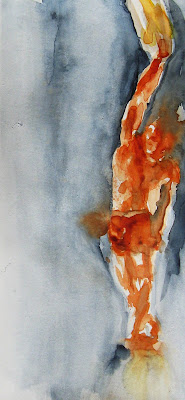The concept of appropriation and reference images came up, so I am going to attempt to convey my jumbled thoughts on the matter.
I think everyone uses reference images in their work. We are all inspired by something. Even the great painters of old had something to look at while they painted--even if that something was a real person, they were nonetheless referencing some image. I think it is impossible to paint without reference. Even the paintings I do while not looking directly at something come from an image in my head, which inevitably came from an image I actually saw. Now this is not to say that there is no difference between painting from life and painting from a photograph, because there is certainly a difference there. Painting from life leaves the painter with the problem of transforming the three-dimensional world into a two dimensional surface. The photograph inevitably eliminates that difficulty since it is already a two-dimensional image. Photographs also cannot, and do not, move or suffer from changes in lighting, which make painting from them easier--and yet this is precisely the value of photographs. Is it so wrong to use your resources? Vermeer used the new technology of his day--the camera obscura--to create more realistic rendering in his painting, and yet those are considered masterpieces. So what is so different about using a reference photo? Photos, of course, also create their own set of challenges. They can lock the painter into one scene and make it difficult to deviate--to make the picture one's own, rather than just a copy of a photograph. But this can also be a good thing. It pushes the artist to think outside the box, and to create a piece that touches on the unseen, rather that just the seen. As artists today, photos can capture the world for us, so we do not have to worry about painting it--we can be free to paint the deeper feelings and emotions and characteristics of life in a new a unique way. I know in my own paintings, reference photos help me with a pose and give me a guide for proportions, but leave me the freedom to adjust everything to create the mood or the emotion I am looking for.
The issue of the photograph also brings me to the issue of appropriation. What happens when one uses someone else's image in their own, either as reference, or literally incorporated in? As noted earlier, I think every artist does, in a sense, appropriate something in their work. We do not live or create in our own little bubble, so we are influences by the work and the images around us. This is a
good thing; it inspires us and pushes us. I am so intrigued by the whole concept of appropriation. It is a dialogue with the past, and it is pushing the boundaries of what has already been done. Now, I don't think is is ok to simply copy someone else's work; it has to be altered or changed or made one's own somehow. Copyright laws also come into effect here, and I do not understand all of the rules regarding that, so I cannot accurately comment on that aspect of this matter. But I certainly would not want to do something that breaks a law, so one must be careful in this area, I suppose.
Lastly, about the debate over whether something is more valuable, or less valuable, because it is more realistic. I don't think that realism equals value at all. There is value in both realism and abstraction--and the whole gamut in between. To me a piece by Jackson Pollock can take my breath away and touch me and make me think as much as a piece by Caravaggio. They are different, yes, but they are both striking.
 I have been experiment with still life paintings lately (hence the image above). It has been a rather frustrating experience. I find still life paintings very uninspiring and I lose all motivation to paint. But I do think it is a rather good exercise technically. So i press onward.
I have been experiment with still life paintings lately (hence the image above). It has been a rather frustrating experience. I find still life paintings very uninspiring and I lose all motivation to paint. But I do think it is a rather good exercise technically. So i press onward.






















